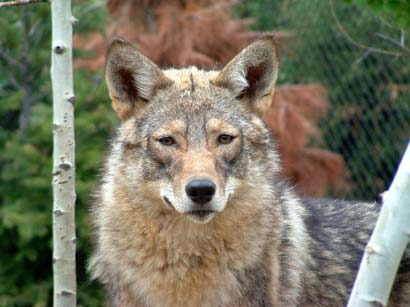
Have you been wakened during the night by the yips and howls of a band of coyotes? Some people regard them as frightening, others as thrilling. However you regard these animals, which have been called coyotes for decades, you might be surprised to learn that they are actually coyote-wolf hybrids.
Our northeastern coyote, a wolf/western coyote hybrid, is larger than the western coyote—more wolf size—and tends to have more variables in fur color. R.W. Kays, former Curator of Mammals at the New York State Museum and now a zoologist at the North Carolina Museum of Natural Sciences, studied coyotes from New Jersey to Maine, and Jonathan Way, wildlife biologist with Eastern Coyote Research, studied coyotes around Cape Cod and Boston. Both teams of scientists found that the animals carry both wolf and coyote DNA.
On a PBS Nature program Dr. Kays showed three skulls, the largest that of the wolf, equipped for eating elk, moose and deer; the smallest that of the western coyote, which preys on rabbits, mice and fruit. The eastern coyote or coywolf has the middle size, with powerful jaws and large teeth suitable for consuming deer.
The story begins with European colonization, when settlers deforested the land and hunted and poisoned the eastern wolf out of existence in the northeast. The remaining wolves abandoned their territory and migrated to Canada, where they bred with the Great Plains coyotes who were pushing eastward. Their descendants bred with coyotes and dogs. When agriculture moved to the Midwest, the coyotes followed the deer to the reforested northeast. Now they have pushed south to Virginia and east to Newfoundland. Dr. Kays estimates that the Eastern Coyote’s hybrid ancestry has allowed it to expand its range five times faster than nonhybrid coyotes could have. They continue to evolve.
They are social animals that travel alone or in packs and mate for life. In their jazzy howl one can sound like four. The astonishing thing about this animal is how readily it has adapted to sharing the landscape with humans. Although there are occasional reports of attacks on people and pets, for the most part, they live quietly and stealthily beside us, little noticed. This includes urban centers; Chicago alone has a population estimated at 2,000, where they are the primary predators of Canada Geese! The hybrid is thriving, often using railroad tracks for their pathways into urban environments. They are smart and resilient but, like other wild animals, they can become a nuisance if fed by humans, so please don’t. Next time you hear one, enjoy the chorus and respect their ingenuity!
